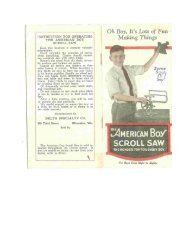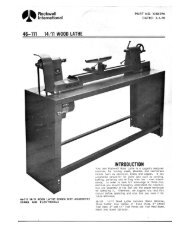Create successful ePaper yourself
Turn your PDF publications into a flip-book with our unique Google optimized e-Paper software.
.<br />
..<br />
CUTTING A SHOULDER. The parting tool is first<br />
used to reduce the wood to within 1/16" of the required<br />
shoulder and diameter, as shown in Fig. 61. The waste<br />
stock is then cleaned out with the gouge, Fig. 62.<br />
Actual cutting of the shoulder is done with the skew,<br />
as shown in Fig. 63, and is a duplication of squaring<br />
end. The horizontal cut is also made with the skew,<br />
but in a little different manner from that used in doing<br />
plain cylinder work. If the shoulder is long, the ordinary<br />
skew position can be used for the outer portion of the<br />
cut, but at the angle between the horizontal and vertical<br />
cuts, the heel of the chisel moves into a position<br />
tangent between the skew and the cylinder, as shown<br />
in Fig. 64. In this position, the handle of the chisel<br />
is raised slightly to allow it to cut as the tool moves<br />
along the rest. A very light cut should be taken in<br />
order to produce smooth work. The heel of the skew<br />
can be used for making the entire cut, if desired, but<br />
the cut, whether in this position or any other position,<br />
should not be picked up directly at the end of the stock.<br />
It is quite evident that any horizontal cut started directly<br />
from the end of the work wi II have a tendency to<br />
bite into the wood, often ruining the entire piece.<br />
Always run off the end and not into it. Where a very<br />
short shoulder makes this impossible, it is best to<br />
use the skew flat in a scraping position. If the cutting<br />
technique is used, engage only with the heel of skew<br />
in a very Iight cut.<br />
CUTTING SMALL BEADS. Beads can be scraped or<br />
cut. The easy method of scraping is done with the<br />
spear chisel, and works to best advantage on beads<br />
separated by parting tool cuts, as shown in Fig. 65.<br />
Scraping is slower and less productive of clean work<br />
than cutting, but it has the advantage of perfect safety -<br />
you won't spoi I the work with long gash tuns.<br />
Cutting beads quickly and accurately with the smail<br />
skew is one of the most difficult lathe operations.<br />
Various working methods can be used, the usual system<br />
being as shown in Fig. 66 , 67 and 68. The first<br />
cut is a vertical incision at the point where the two<br />
curved surfaces wi II eventually come together. This<br />
cut can be made with either heel or toe of skew, Fig. 69<br />
showing the toe being used. Now, place the skew at<br />
right angles to the work and well up on the cylinder,<br />
as shown in Fig. 66. The chisel is flat on its side<br />
at the start, and is evenly rotated through the successive<br />
stages of the cut, as shown in Fig. 66 , 67 and 68.<br />
At the same time, the chisel is pulled slightly backwards<br />
to maintain the cutting point. The entire cut<br />
is made with the heel of chisel. The opposite side<br />
of the bead is cut in the same manner, .one cut serving<br />
to produce the full shape in each instance. Beads cut<br />
in this manner are beautifully smooth and polished,<br />
and the technique is well worth mastering.<br />
17<br />
SPEAI1<br />
POINT<br />
CHISEL.\-.,<br />
Fig 62<br />
CL.EAN oUT<br />
THE WASTE<br />
STOCk: WITH<br />
THE GOuGE<br />
USE THE TOE<br />
OF THE SKEW<br />
TO MAI(E T"E<br />
VERTICALCUT<br />
_1~ING TOOL CUTS<br />
/ , i ,' ~m<br />
Fig 64<br />
Fig 66 Fig 67<br />
Fig65<br />
Fig69<br />
[Qm]<br />
Fig68<br />
...








